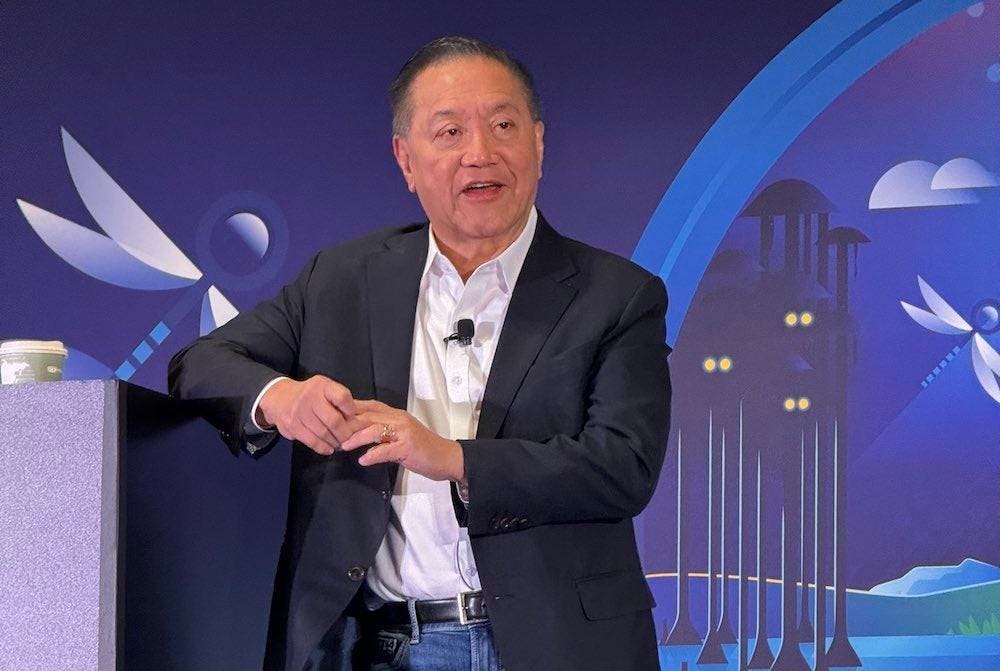Broadcom CEO Hock Tan answers questions about VMware during an analyst Q&A session at VMware Explore 2024.
Patrick Moorhead
Broadcom CEO Hock Tan took the stage at Explore 2025 to make his case for why VMware Cloud Foundation is the optimal platform for enterprises struggling with modernization and AI in this increasingly volatile world. His keynote focused mainly on private cloud as the foundation of the transformed enterprise, where IT becomes an enabler of innovation instead of an inhibitor. Private cloud is also where organizations can focus on delivering AI and what’s next, knowing that security, governance and compliance are givens rather than points of concern. One must modernize to do AI well, but modernizing solves for many other non-AI-related initiatives, too.
Despite this, Broadcom continues to face challenges from the likes of Nutanix, Red Hat and others trying to capitalize on the disruption caused by Broadcom’s acquisition of VMware — even though the deal closed nearly two years ago. So, how did Tan’s keynote land? Is this private cloud thing real? And is VCF the compelling private cloud — and private AI platform — that VMware claims? Let’s dig in.
(Note: Broadcom is an advisory client of our firm, Moor Insights & Strategy, as are many of its competitors.)
The Disruptive Private Cloud Market
As almost anyone following this sector knows by now, the virtualization and private cloud market was disrupted when Broadcom acquired VMware for roughly $60 billion in 2023. Almost immediately following the close of the deal, Broadcom began to implement licensing and support changes that would align with its long-term goal of rationalizing the VMware portfolio and tying all the company’s technology into a single integrated private cloud platform. At the same time, the company also doubled down on cloud R&D.
While competitors attempted to exploit this disruption through marketing campaigns, the company built VCF 9.0. At VMware Explore 2024, Tan unveiled this platform, using Broadcom’s internal experience with private cloud as his case study. A large global company with multiple lines of business trying to consume the public cloud and all of this great VMware technology was losing in terms of cost, control and organizational integration. VCF 9.0 was the platform that delivered on the promise of the cloud without the cost and complexity.
Fast-forward a year, and Tan’s keynote comes at a time when the company’s latest reported earnings showed its software division returning $6.6 billion in revenue, which represents 25% year-over-year growth. This top line, along with a 76% operating margin, was reported as Tan declared that 87% of Broadcom’s top 10,000 customers renewed their licenses. (Note: Broadcom will announce its FY2025 Q3 earnings on September 4.)
Despite this incredible growth, competitors and naysayers framed this as simply a step in the migratory process as large customers look to untangle their VMware dependence — a process that inevitably takes time.
We believe the long-term answer depends on one thing: how much value does Broadcom deliver with VCF? Perhaps a better way of saying this is, how much value do customers realize from using VCF?
VCF 9.0 Is Private Cloud Reinvented
Private cloud is not a new term. Those who have been around this industry for some time may remember this term gaining popularity in the 2008 timeframe as private organizations tried to mimic the public cloud with their own virtualized infrastructures with some hint of a self-service portal wrapped around them. Despite the failures companies ran into due to back-end complexity, organizations realized even back then that fully embracing the public cloud was not the answer.
The numbers don’t lie. Broadcom’s own research showed that 92% of IT executives surveyed said they trust the security of their own private cloud more than the public cloud. And 70% of those executives cite the need to repatriate at least some of their applications and data on-premises. This is not a revolution against public cloud; rather, it’s a rationalization process as companies find the right balance of public to private.
As part of Tan’s keynote, he looped back to what Broadcom delivered in VCF 9.0, a product innovation cycle that consumed over 1 million engineering hours and resulted in more than 8,000 patents. Tan focused on three main themes for IT operations — themes that bring the promise of a public cloud experience to the private cloud.
- Increasing developer velocity without compromising IT control. Anybody who has been in IT understands the tension between IT and the business side. Application developers and data scientists need to be able to spin up environments quickly to build and deploy applications anywhere. On the other hand, IT organizations need to ensure that policies and guardrails are not compromised. VCF 9.0 delivers the cloud experience developers want while enabling IT to ensure that its guardrails and policies underpin the provisioned environments.
- Delivering speed of innovation with inherent security. Everybody acknowledges and embraces the idea that security is absolutely critical to the enterprise. However, many have a frustration with the hundreds of security products deployed and running in an unoptimized way. With VCF 9.0, Broadcom has built security into the lowest levels of the platform and up the stack to embed security everywhere so users can consume IT services without worrying about integrating security.
- Maintaining a cloud platform that supports the needs of today and tomorrow. This is really about how to manage the old and the new. Or the present and the future. For many organizations, these are two compute, storage and networking environments managed by two teams. Broadcom believes it has the one, hybrid platform that can support legacy lines of business applications alongside your agentic AI applications.
The question is, does VCF deliver this modern cloud experience and meet these three key requirements? We believe the answer is yes. Tan laid out this vision at last year’s Explore, which we found quite compelling. This year, he is showing how the company has executed and how customers have realized these benefits.
One of Broadcom’s customers made a simple yet profound statement: “Stop thinking of your environment as servers and storage and networking; think of it as a cloud platform.” When adopting this mindset, the value of VCF becomes apparent. This is a modern way to look at things.
Next-Generation VCF — Private AI-As-A-Service And More
The requirements that guide an enterprise toward private cloud will also guide it toward private AI as enterprise adoption of AI happens in earnest. The same challenges — security, speed and optimizing infrastructure — are perhaps even more critical.
The keys are to bring models to where the data is and to provide customers with choice. This is what private AI-as-a-service is: Deliver a platform that allows customers to utilize the models they want for their data on their own infrastructure — Nvidia, AMD or Intel.
Effectively, VCF is delivering its own AI factory at no cost. However, rather than forcing customers into a specific architecture or framework, Broadcom allows them to use their chosen tools.
This is compelling for activating AI in the real world. While hyperscalers and the largest of the large enterprise customers can afford to invest in the most costly and performant infrastructure and tooling (and refresh it every year), the rest of the market needs to leverage the infrastructure they’ve already invested in. And they need to make AI as frictionless as possible. This is what private AI-as-a-service aims to deliver.
How Broadcom Can Win In This Market
Broadcom has delivered a compelling platform with VCF 9.0. More importantly, it has painted a vision that we believe aligns nicely with how the IT organization of tomorrow can deliver the speed and autonomy that developers want without compromising on security, control or cost.
Despite all of this product goodness and VCF’s incumbency in the market, some mistimed licensing and channel announcements early on sowed seeds of doubt among VMware customers. This gave Broadcom’s competitors a lot of ammunition to try to capture market share.
Are Broadcom’s competitors going to be successful — either by beating VCF on the merits, or as they continue to drive FUD in the marketplace? How does Broadcom counter?
We believe that while the company has quietly designed and delivered the leading private cloud platform, it should be more vocal and direct in the market. While competitors claim to be the more affordable option, these claims are often based on upfront discounts that don’t fully account for cost over the long term. And while these competitors talk about vendor lock-in, they are in reality simply suggesting that customers move from one proprietary cloud stack to another.
We would like to see Broadcom deliver deeper analysis comparing itself against its main competitors, showing what a fully burdened cost of ownership would look like on VCF versus other cloud platforms. We would also like to see the company showcase more of its customer successes with companies both large and small, such as it did with Grinnell Mutual and Barclays during today’s keynote. These proof points will help the company counter the market noise being generated. Even better would be all this storytelling with concrete business outcomes included.
Regardless of its go-to-market activities, Broadcom has nailed the technical capabilities with VCF 9.0. When thinking of the needs of the modern enterprise today (and tomorrow), Broadcom has shown it has delivered the right platform for the right time.
Moor Insights & Strategy provides or has provided paid services to technology companies, like all tech industry research and analyst firms. These services include research, analysis, advising, consulting, benchmarking, acquisition matchmaking and video and speaking sponsorships. Of the companies mentioned in this article, Moor Insights & Strategy currently has (or has had) a paid business relationship with AMD, Broadcom, IBM (Red Hat), Intel, Nutanix and Nvidia.









